Elephant seal
| Elephant seal | |
|---|---|
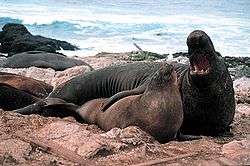 | |
| Male and female northern elephant seals | |
| Scientific classification | |
| Kingdom: | Animalia |
| Phylum: | Chordata |
| Class: | Mammalia |
| Order: | Carnivora |
| Suborder: | Pinnipedia |
| Family: | Phocidae |
| Genus: | Mirounga Gray, 1827 |
| Species | |
Elephant seals are large, oceangoing earless seals in the genus Mirounga. The two species, the northern elephant seal (M. angustirostris) and the southern elephant seal (M. leonina), were both hunted to the brink of extinction by the end of the 19th century, but the numbers have since recovered.
The northern elephant seal, somewhat smaller than its southern relative, ranges over the Pacific coast of the U.S., Canada and Mexico. The most northerly breeding location on the Pacific Coast is at Race Rocks, at the southern tip of Vancouver Island in the Strait of Juan de Fuca. The southern elephant seal is found in the Southern Hemisphere on islands such as South Georgia and Macquarie Island, and on the coasts of New Zealand, South Africa, and Argentina in the Peninsula Valdés, which is the fourth-largest elephant seal colony in the world. In southern Chile, there is a small colony of 120 animals at Jackson Bay, Admiralty Sound (Seno Almirantazgo), Tierra del Fuego.[1] The oldest known unambiguous elephant seal fossils are fragmentary fossils of an unnamed member of the tribe Miroungini described from the late Pliocene Petane Formation of New Zealand.[2] Teeth originally identified as representing an unnamed species of Mirounga have been found in South Africa, and dated to the Miocene epoch;[3][4] however Boessenecker & Churchill (2016) considered these teeth to be almost certainly misidentified odontocete teeth.[2]
Elephant seals breed annually and are seemingly faithful to colonies that have established breeding areas.[5]
Description
Elephant seals take their name from the large proboscis of the adult male (bull), which resembles an elephant's trunk.[6] The bull's proboscis is used in producing extraordinarily loud roaring noises, especially during the mating season. More importantly, however, the nose acts as a sort of rebreather, filled with cavities designed to reabsorb moisture from the animals' exhalations.[7] This is important during the mating season when the seals do not leave the beach to feed, and must conserve body moisture as they have no incoming source of water. These animals are colossally large in comparison with other pinnipeds, with southern elephant seal bulls typically reaching a length of 5 m (16 ft) and a weight of 3,000 kg (6,600 lb), and are much larger than the cows, with some exceptionally large males reaching up to 6 m (20 ft) in length and weighing 4,000 kg (8,800 lb); cows typically measure about 3 m (10 ft) and 900 kg (2,000 lb). Northern elephant seal bulls reach a length of 4.3 to 4.8 m (14 to 16 ft) and the heaviest weigh about 2,500 kg (5,500 lb).[8][9]
Physiology

Elephant seals spend upwards of 80% of their lives in the ocean. They can hold their breath for more than 100 minutes[10][11] – longer than any other noncetacean mammal. Elephant seals dive to 1,550 m beneath the ocean's surface[10] (the deepest recorded dive of an elephant seal is 2,388 m (7,835 ft) by a southern elephant seal).[12] The average depth of their dives is about 300 to 600 m (980 to 1,970 ft), typically for around 20 minutes for females and 60 minutes for males, as they search for their favorite foods, which are skates, rays, squid, octopuses, eels, small sharks and large fish. Their stomachs also often contain gastroliths. While excellent swimmers, they are also capable of rapid movement on land.
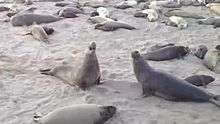
Elephant seals are shielded from extreme cold by their blubber, more so than by fur. The animals' hair and outer layers of skin molt in large patches. The skin has to be regrown by blood vessels reaching through the blubber. When molting occurs, the seal is susceptible to the cold, and must rest on land, in a safe place called a "haul out". Northern males and young adults haul out during June to July to molt; northern females and immature seals during April to May.
Elephant seals have a very large volume of blood, allowing them to hold a large amount of oxygen for use when diving. They have large sinuses in their abdomens to hold blood and can also store oxygen in their muscles with increased myoglobin concentrations in muscle. In addition, they have a larger proportion of oxygen-carrying red blood cells. These adaptations allow elephant seals to dive to such depths and remain underwater for up to two hours.[13]
Milk produced by elephant seals is remarkably high in milkfat compared to other mammals. After an initially lower state, it rises to over 50% milkfat (human breast milk is about 4% milkfat, and cow milk is about 3.5% milkfat).[14]
Lifespan
Northern female elephant seals have lived for 22 years, and can give birth starting at the age of three to four. Males reach maturity at five to six years, but generally do not achieve alpha status until the age of eight, with the prime breeding years being between ages 9 and 12. The longest life expectancy of a male northern elephant seal is approximately 14 years.
Status
The IUCN lists both species of elephant seal as being of least concern, although they are still threatened by entanglement in marine debris, fishery interactions, and boat collisions. Though a complete population count of elephant seals is not possible because all age classes are not ashore at the same time, the most recent estimate of the California breeding stock was approximately 124,000 individuals. In the United States, the elephant seal, like all marine mammals, is protected under the Marine Mammal Protection Act (MMPA), passed in 1972, which outlaws hunting, killing, capture, and harassment of the animal.[15]
Gallery
-
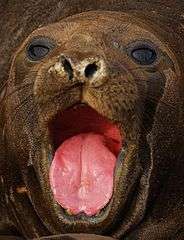
South Georgia elephant seal
-

Elephant seals (Mirounga angustirostris) on Piedras Blancas beach, near San Simeon, California
-

Male, female and pup
-

Northern elephant seals during molting season at Piedras Blancas beach, near San Simeon, California
-

Two bulls fighting
-
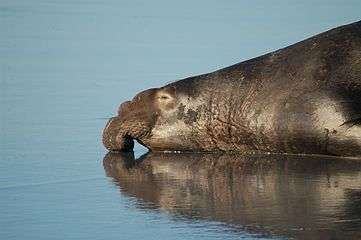
Elephant seal snout
-

Juvenile southern elephant seal
-
Beachmasters, the dominant bulls fighting at Macquarie Island
-
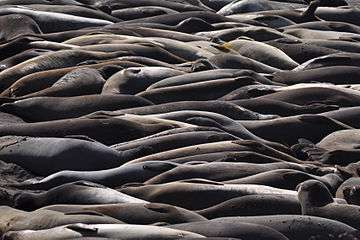
Elephant seals at Piedras Blancas, California
See also
References
- ↑ "WCS Chile > Especies > Elefantes marinos". programs.wcs.org. Retrieved 2016-05-27.
- 1 2 R.W. Boessenecker; M. Churchill (2016). "The origin of elephant seals: implications of a fragmentary late Pliocene seal (Phocidae: Miroungini) from New Zealand". New Zealand Journal of Geology and Geophysics. 59 (4): 544–550. doi:10.1080/00288306.2016.1199437.
- ↑ Martin Pickford; Brigitte Senut (1997). "Cainozoic mammals from coastal Namaqualand, South Africa". Palaeontologia Africana. 34: 199–217.
- ↑ Berta, A.; Churchill, M. (2012). "Pinniped Taxonomy: evidence for species and subspecies". Mammal Review. 42 (3): 207–234. doi:10.1111/j.1365-2907.2011.00193.x.
- ↑ http://www.plosgenetics.org/article/info:doi/10.1371/journal.pgen.1000554
- ↑ Mirounga. "Elephant Seal, Elephant Seal Profile, Facts, Information, Photos, Pictures, Sounds, Habitats, Reports, News - National Geographic". Animals.nationalgeographic.com. Retrieved 2009-01-08.
- ↑ A. C. Huntley; D. P. Costa; R. D. Rubin (1984). "The contribution of nasal countercurrent heat exchange to water balance in the northern elephant seal, Mirounga angustirostris". Journal of experimental biology. 113: 447–454.
- ↑ "Elephant Seals". Parks.ca.gov. 2007-05-23. Retrieved 2009-01-08.
- ↑ "Elephant Seal - MSN Encarta". Encarta.msn.com. Archived from the original on 2009-10-31. Retrieved 2009-12-29.
- 1 2 Amos, Jonathan. "Elephant seals dive for science". 2006. BBC News. Retrieved 23 April 2013.
- ↑ "Southern Elephant Seals of Sea Lion Island - A Long-term Research Project" (PDF). www.eleseal.org. Retrieved 2010-05-21.
- ↑ "Census of Marine Life - From the Edge of Darkness to the Black Abyss" (PDF). Coml.org. Retrieved 2009-12-15.
- ↑ "5.4 Seals". Classroom Antarctica. Retrieved July 2011. Check date values in:
|access-date=(help) - ↑ "Northern Elephant Seal Fact Sheet" (PDF). Coastside State Parks Association. Retrieved 26 March 2013.
- ↑ "NOAA's National Marine Fisheries Service - Northern Elephant Seal (Mirounga angustirostris)".
External links
| Wikimedia Commons has media related to Mirounga. |
- Tagging of Pacific Predators, Elephant Seals
- Friends of the Elephant seal
- Elephant Seal Research Group
- Elephant seals
- Dr. Daniel Costa's Research Laboratory
- Elephant Seals at Race Rocks, Canada
- Teen Spots Hagfish-Slurping Elephant Seal - YouTube (2:11)